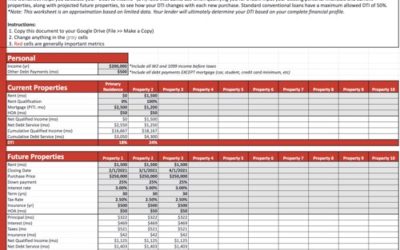You oftentimes hear on the news: “The Federal Reserve raised (or lowered) rates by 25 basis points”. But what does that mean exactly for you as a consumer trying to get a loan on a house?
TLDR
There’s little to no correlation with mortgage rates. A better proxy to watch is the benchmark 10-Year U.S. Treasury Note.
The full story…
The Federal Reserve (“Fed”) interest rate, more commonly called the “Fed Funds Rate”, is the rate at which banks lend money to other banks. To ensure liquidity and prevent another Great Depression, the Fed was created to oversee monetary policy and control the flow of money going into the economy. Because the Fed actively monitors the local and global economies, the Fed Funds Rate has become a good proxy as to the perceived health of the U.S. economy. When they raise or lower rates it means something important about the economy and inflation.
While it may seem counterintuitive, what this means for mortgage loans is entirely different. This is because the Fed Funds Rate really only affects short-term, bank-to-bank loans. If you were to get a car loan, for example, having a lower Fed Funds Rate would presumably help you get a lower rate on your loan. Mortgage rates, however, are typically not bank-to-bank loans, but instead are packaged entities of debt (called Mortgage Backed Securities) that are bought and sold on a secondary market. Yes, someone else actually paid money to buy YOUR debt in your home. Crazy, isn’t it?
The secondary market is where the real action is. Big institutional investors have the option of putting their money in many places. They could place it in the stock market for example, or they could buy Mortgage Backed Securities (MBS) on the secondary market. Where they place their money depends on their expectation for return. When the economy is booming and the stock market is soaring, they could get a potentially higher return by investing in stocks. On the flip side, when the stock market is in a rut, they could get a potentially higher return by buying MBS’s, which return a mostly fixed yield. Since MBS’s are traded just like stocks and bonds, their price (and yield) fluctuates just like stocks and bonds. The laws of supply and demand would then dictate that when more people are trying to buy a fixed quantity of something, the cost of those somethings then goes up. In the case of MBS’s, it’s the yields that go up and down. The higher the yield, the higher the interest rate that banks can charge on new loans that then get packaged up and sold as MBS’s.
Here’s an easy way to think about it. Pretend you have a lemonade stand. You sell lemonade to your neighbors, but instead of paying you in cash, they pay you in poker chips. In order for you to make real money, you then have to cash in those poker chips to somebody else and get real money in return. That is the secondary market, where these poker chips are cashed in and out. Now imagine that the poker-chip to dollar ratio fluctuates on a daily basis. Sometimes the value goes up and sometimes it goes down. You’re in the lemonade business to make real money, so as this ratio changes, you would have to raise and lower your lemonade prices to account for the change in conversion rate.
All that said, there is a better (and albeit much easier) way to track/predict interest rates… the benchmark 10-Year U.S. Treasury Note. Because treasury notes are another alternative to the stock market, they function as a good proxy for mortgage interest rates. When rates fall, mortgage rates fall right there with them. If you’re thinking of locking a loan and are on the fence as to whether rates will go up or down tomorrow, it would be worth your while to take a look at this benchmark over the last few months to help with that decision.





